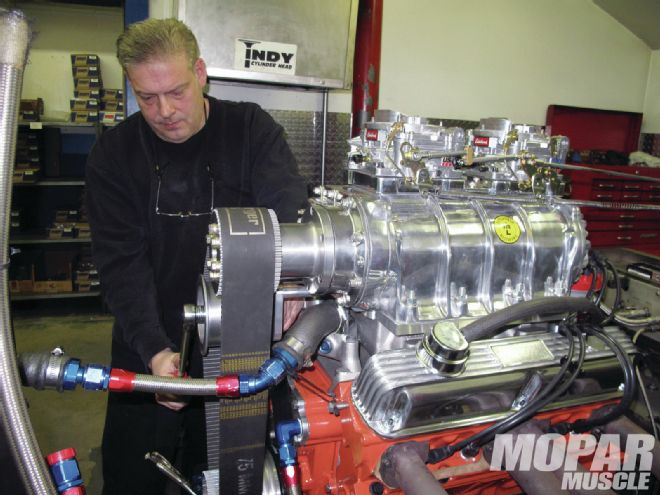
Since the 273 V-8 was introduced, the Chrysler LA series small-block engine has become a hit with Mopar performance enthusiasts. Packaged in a small, lightweight block, the small-block Mopar is some 150 pounds lighter than a comparably equipped big-block. When the 340 engine was introduced, it sealed the deal, as it was quite a match for any off-brand small-block, and the 360 LA and Magnum versions of this engine are proven powerhouses as well. Thanks to great aftermarket support for the Mopar small-block, displacements, and power levels, are far greater now than they have ever been, allowing the small-block Mopar to make power numbers previously reserved for big-block or Hemi engines.
One company that has embraced the Chrysler small-block is Indy Cylinder Head. Taking advantage of our annual Engine Challenge several years ago, the crew at Indy used their entry to team up with RHS, developing the Indy LA-X line of cylinder heads. Indy also won our Engine Challenge that year, as their small-block made more power and torque than any of the other seven entries. Indy has a full line of parts you need to build your own Mopar small-block engine, or they offer complete engines if you'd rather not do it yourself. During this year's annual Chrysler technical seminars and swap meet at the Indiana State Fairgrounds, we noticed one small-block offered by Indy Cylinder Head that could make three different levels of power, all with the same intake manifold. Intrigued, we decided to visit them and check out what it takes to build this potent 408-inch small-block, and then test it on the dyno using a single four-barrel, dual-quads, and a supercharger with dual-quads.
The basis of this engine is a 360 block with a 4.030-inch bore size and an Eagle forged crankshaft with a stroke of four inches, for a total displacement of 408 cubic inches. Forged dish pistons with coated skirts combined with Indy's LA-X cast-iron cylinder heads give the engine a pump-gas friendly 9.0:1 compression ratio, and I-beam forged connecting rods are utilized. A Milodon road race oil pan and Melling oil pump handle the lubrication duties.
For improved flow and power potential, Indy treated the LA-X cylinder heads of this engine to CNC bowl porting, and the heads feature 2.055-inch intake and 1.625-inch exhaust valves. These heads offer longer valves than standard LA heads, with Magnum style combustion chambers and ports, while retaining the shaft mounted rocker arms. Indy also offers a version of this cylinder head featuring individual Magnum-style rocker arms, making this a versatile, great performing head.
Since this engine was designed to run well both naturally aspirated or with a blower providing boost, camshaft selection was critical. Engine builder Ken Lazzeri of Indy Cylinder Head chose a Comp Cams hydraulic flat-tappet cam for this engine, for simplicity and cost effectiveness. This special grind camshaft features .544-inch intake lift and .541-inch exhaust lift, with 240- and 246-degree duration ratings for the intake and exhaust respectively. Lobe separation for this grind is 110 degrees, and Ken installed the cam at 108 degrees. Indy Cylinder Head roller rocker arms are utilized with a ratio of 1.6 on both the intake and exhaust side.
The item that makes this engine so versatile is the Mod Man intake manifold built by Indy Cylinder Head. This intake allows the user to change between a single four-barrel, two four-barrel plate, Six-Pack plate, or even a blower plate. This is an exceptional benefit on the small-block engine since on a small-block, the intake manifold houses water jackets requiring the coolant be drained to change the intake. For our dyno session, we decided to test the single four-barrel version using a 750-cfm Holley, then use a pair of 500-cfm Edelbrock carbs on the dual-quad top plate, before finishing off our test with a 671 Littlefield blower attached to the blower top plate.
Starting with the single four-barrel, we fired the engine up on the dyno to begin our testing. This is a throaty small-block, and with 408 inches of displacement and sounds more like a big-block when it's running. Indy offers a version of this same engine with the MA-X (Magnum style) cylinder head and a slightly milder camshaft and slightly smaller valves rated at 450 horsepower with one four-barrel, so we were eager to see what this little powerhouse could produce. On the first dyno pull, it was evident that this small-block ran well, as peak torque was 481.8 lb-ft and peak horsepower was 495.9 horsepower at 5,900 rpm. A big part of this story, however, is the Mod Man intake this small-block is equipped with.
Thanks to Indy's Mod Man, we could quickly make dyno pulls, then change the top plate of the intake in about 20-30 minutes and be ready to dyno the engine again. We accomplished multiple pulls on this engine with three different induction setups, and easily accomplished all of our work in a day on the dyno. Even more impressive is the power this engine made. Check out the dyno results below and we're sure you'll agree that this 408 shows its potential both normally aspirated and with the blower. Also be sure to check out moparmusclemagazine.com for a video of this powerful small-block making pulls on Indy's dyno.
Price Tag
450hp 408 small-block complete$6,479 (single four-barrel) 520hp 415 small-block complete$7,595 (single four-barrel) Indy Mod Man intake$499 Mod Man top plates$135 each The power and torque of a supercharged small-blockpriceless